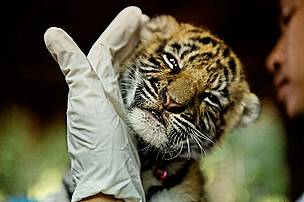CITES keeps spotlight firmly on Asian tiger farms
Posted on September, 29 2016
Laos also announced it will close all its tiger farms
With tiger farms in Asia coming in for increasing global scrutiny, important progress was made towards closing them at CITES CoP17 today, restarting a process that had been stalled since 2007 – when agreement was first reached on the need to phase them out.Critically, China’s proposal to remove the existing CITES requirement to control such captive facilities was rejected by all other parties, suggesting governments worldwide are not willing to relax trade in captive bred tigers.
The decision comes after the release of a WWF and TRAFFIC tiger trafficking report, which found no slow down in the illegal tiger trade. In addition, the report found that almost 30% of tigers seized between 2012 and 2015 were believed to come from captive facilities – highlighting the urgent need to tackle tiger farms, which are fuelling the illegal trade.
In another important development, Laos confirmed it will be closing all its tiger farms.
“Laos has set a strong precedent for the rest of Asia by confirming it will close its tiger farms,” said Heather Sohl, WWF-UK’s chief advisor on wildlife, who is attending the CoP.
“The decision made today by CITES to review captive tiger facilities will provide much needed insight into these illicit practices. There has been an international ban on the trade in tigers and their products for decades yet poaching remains the greatest threat to their survival – and it is clear that captive breeding facilities are playing an increasing role in the illegal trade.”
“In 2007, CITES passed a motion to tackle the role of tiger farms in the illegal trade. Nine years later, Asia has more tiger farms, more tigers in them and more tiger trafficking. We are running out of time. However, with today’s agreements, along with the continued efforts of conservationists, we hope that tiger farms will soon be a thing of the past,” added Sohl.
Meanwhile, India called on countries to share photographic evidence of seized tiger skins and create an international photographic database of wild tigers to compare them too. This collaborative initiative aims to greatly aid officials in tracing seized skins back to their source. This will offer valuable insight into poaching, trade routes and population numbers, so helping law enforcement.
WWF and TRAFFIC intervened during the debate.
“We fully support India's proposal, and regard this as an important step forward in the fight against illegal tiger trade,” said Sabri Zain, TRAFFIC Global Policy Director.
“TRAFFIC and WWF have just released a report with an analysis of tiger seizures between 2000 and 2015, the findings of which clearly indicate that skins remain the most highly traded commodity. So this proposal, if accepted, will aid efforts towards better understanding sources and trade patterns being employed by criminal networks, and will be an extremely valuable tool for tiger range countries in safeguarding their tigers.”
However, the success of this resource will depend on a united approach from all tiger range countries. This proposal will continue to be discussed later in the conference.
Related links







